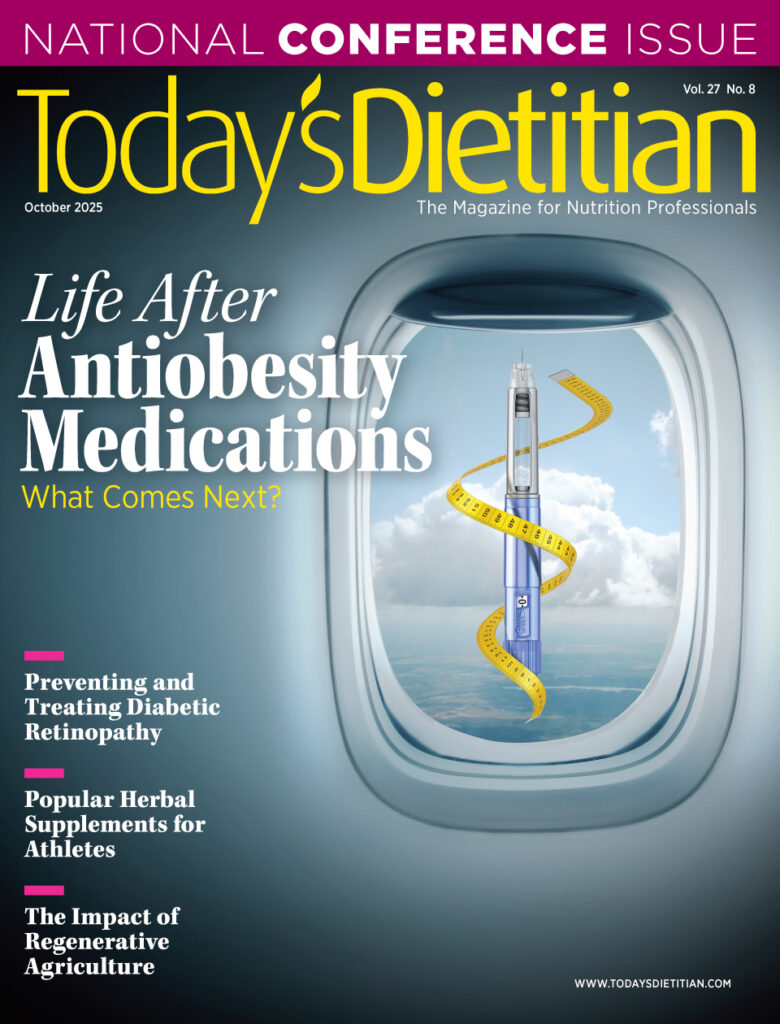Today’s Dietitian
Vol. 18, No. 12, P. 10
Q: What is ugly produce, and does it have the same nutrient profile as its mainstream counterpart?
A: Imperfect fruits and vegetables are known as “ugly produce.” Despite their cosmetic flaws, these fruits and vegetables provide as much nourishment as—and sometimes more than—supermarket-stocked blemish-free produce.
Why Ugly Produce?
At the retail level, supermarkets have specifications when purchasing fruits and vegetables to meet consumer demand for perfectly shaped produce. Supermarket distributors will purchase only produce without blemishes or scabs and even insist on how they’re laid out in the crate, both of which are practices that lead to waste. Produce that doesn’t meet size, shape, or color specifications retailers expect will remain unsold and discarded. These include cucumbers with “weird curves,” blemished tomatoes, bruised peaches, and apples that are “too small.” These fruits and vegetables, however, are tasty and healthful, and provide the same (and in some cases more) nutrients than their cosmetically perfect cousins.
Food waste occurs at each stage of food production and distribution, from farmers to packers and shippers to manufacturers and retailers. An estimated 70 billion lbs of food are wasted in America each year, which includes 6 billion lbs of fresh produce.1 That’s enough food waste to fill four football stadiums. According to the Environmental Protection Agency, 96% of wasted food in the United States ends up in landfills or combustion facilities.2 Once in landfills, the produce begins to break down and emit methane, a greenhouse gas that contributes to climate change.
Nutrient Profile
Infections or microbial intrusions can cause physical blemishes to produce but not necessarily make it unsafe to eat. In fact, several studies have shown that some imperfect fruit and vegetables that fall victim to infection have higher amounts of phytochemicals. A study published in the June 2010 issue of The Journal of Horticultural Science & Biotechnology found that apples covered in scabs in response to an infection had higher amounts of phenolic compounds.3 A second study found that harvested Golden Delicious apple leaves that were infected with fungus contained higher amounts of the phenolic compounds hydroxycinnamic acid, flavanols, and phloridzin, while they contained lower amounts of procyanidins, quercetins, and phloretin.4 However, there are many factors that contribute to the varying phytochemical levels in fruits and vegetables. Consuming both ugly and conventional produce can help the US population meet the USDA’s recommended daily amount for fruit and vegetable consumption, a challenge for most people.
Minimizing Waste
Inform clients that ugly fruits and vegetables are tasty and nutritious. RDs and clients alike can do the following to reduce produce waste:
• Purchase and consume imperfect fruits and vegetables from farmers’ markets or when picking your own. Some supermarkets like Giant Eagle (www.gianteagle.com) offer consumers reduced prices for imperfect fruits and vegetables in some locations.
• Order recovered (aka ugly) produce from organizations like Hungry Harvest (www.hungryharvest.net), which recovers farm-fresh fruits and vegetables and delivers to areas on the East Coast. Imperfect Foods (www.imperfectproduce.com) is a similar organization on the West coast that also has teamed up with Whole Foods to sell imperfect produce in select stores.
• Sell or share your homegrown excess produce, perfect or not, through Ripe Near Me (www.ripenear.me), an organization whose mission is to reduce food waste, improve global food security, and increase urban and sustainably grown foods.
— Toby Amidor, MS, RD, CDN, is the founder of Toby Amidor Nutrition (http://tobyamidornutrition.com) and the author of the cookbook The Greek Yogurt Kitchen: More Than 130 Delicious, Healthy Recipes for Every Meal of the Day. She’s also a nutrition expert for FoodNetwork.com and a contributor to US News Eat + Run, MensFitness.com, and Muscle & Fitness.
References
1. Securing and distributing meals. Feeding America website. http://www.feedingamerica.org/about-us/how-we-work/securing-meals. Accessed October 5, 2016.
2. Reducing wasted food at home. Environmental Protection Agency website. https://www.epa.gov/recycle/reducing-wasted-food-home. Updated August 24, 2016. Accessed October 5, 2016.
3. Slatnar A, Petkovsek MM, Halbwirth H, Stampar F, Stich K, Veberic R. Response of the phenylpropanoid pathway to Venturia inaequalis infection in maturing fruit of ‘Braeburn’ apple. J Hortic Sci Biotechnol. 2010;85(6):465-472.
4. Petkovsek MM, Slatnar A, Stampar F, Veberic R. Phenolic compounds in apple leaves after infection with apple scab. Biol Plant. 2011;55(4):725-730.


